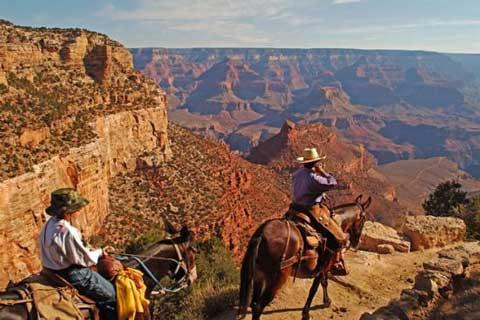A trail reconstruction project on the South Kaibab Trail at Grand Canyon National Park has led to some changes in mule trips at the park. The overnight trip to Phantom Ranch is not affected, but the day trip to Plateau Point has been replaced by a ride to an overlook featuring a view with a classic Grand Canyon name: The Abyss.
The South Kaibab and the Bright Angel are the two most heavily-used trails from the park's South Rim to the Colorado River. Both are usually shared by hikers, mules and occasionally horses, but the South Kaibab is currently in the midst of a long overdue multi-year rehabilitation project.
During that work, all livestock use other than that required to support the construction project has been shifted from the South Kaibab to the Bright Angel Trail. The end result: The Bright Angel became home to both uphill and downhill supply trips to Phantom Ranch (at the bottom of the Canyon) and concessioner-operated mule trips to and from Phantom Ranch and Plateau Point.
According to information from the park,
Prior to the start of the South Kaibab reconstruction project, all of Xanterra’s overnight mule trips to Phantom Ranch departed on the Bright Angel Trail and returned on the South Kaibab Trail. Currently those trips are departing and returning on the Bright Angel Trail. Grand Canyon National Park’s 1995 General Management Plan allows Xanterra 60 mule passes (not including guide mules) on the Bright Angel Trail and 20 mule passes on the South Kaibab Trail each day. The temporary rim ride will allow Xanterra to continue their overnight mule trips to Phantom Ranch without exceeding their daily limit on the Bright Angel Trail.
Changes in those trips went into effect this week. The seven-hour round trip from the South Rim to Plateau Point, an overlook within the canyon that provides a view of the Colorado River, has been replaced with a shorter trip that will avoid the Bright Angel Trail entirely.
Xanterra, the park concessioner that operates the trips, provided some details about the new ride to the Abyss overlook.
From March 15 through Oct. 31 the Abyss Overlook Mule Ride departs at 9:00 a.m. and 1:00 p.m., and from Nov. 1 through March 14 the ride departs once each day at 10:00 a.m. All trips feature a maximum of 20 riders and will depart from the main livery barn in Grand Canyon Village.
The ride follows a trail heading west through a forest of ponderosa pine, piñon pine and junipers to the rim of the Grand Canyon. The ride is approximately one hour and 15 minutes each way with a half-hour stop at the Abyss where riders can dismount to stretch their legs and shoot photos. The Abyss features a 3,000-foot vertical drop and views of many of the Grand Canyon’s colorful pinnacles, buttes and mesas. The rides return on the same trail.
The park is currently completing an Environmental Assessment (EA) for all mule operations and stock use in the park.
The environmental assessment and associated decision document will be the basis for future mule and stock use within the park. The environmental assessment is expected to be completed later this year. Once completed, the NPS will hold public meetings to provide information, answer questions, and take comments on stock use in the park.
As reported earlier this year on the Traveler, the question of livestock use on trails at the park has been the subject of a lively and ongoing discussion, and work on the EA confirms that there's still no shortage of opinions on the subject. You can see a summary of comments received by the NPS during the "scoping" process for the EA at this site, but the following sampling offers a glimpse at the challenge facing the park staff when they try to take public comments into account when reaching a decision:
Among the suggestions made by the public:
• "Use helicopters to supply Phantom Ranch, not mules (eliminate mule use)"…and... "Use mules to service Phantom Ranch, not helicopters."
• "Do not allow private stock use"…and... "NPS should retain the ability to bring and use private stock in the park."
• "Stock use provides for hiker safety by enabling rescue of injured hikers" …and... "Mule use leads to safety issues for hikers."
Now, don't you wish you were a park planner?




Comments
There's currently a job opening for Chief of Planning for Yosemite. although I believe it is restricted to current federal employees (doesn't increase the federal employee count, and helps ensure relevant experience):
http://jobview.usajobs.gov/GetJob.aspx?JobID=83612198
I wouldn't take that job for triple the salary!
My boyfriend and I hiked the S Kaibab trail down to Colorado and then came back up to the south rim via Bright Angel in just under 7 hours. It was absolutely amazing! I would recommend that you bring a pair of binoculars. I personally liked the S Kaibab better than Bright Angel...it was steeper but the views are breathtaking and the hike was just more interesting in my opinion. We took a shuttle from Bright Angel Lodge to the trailhead at 8:00 and it was 29 degrees out, but by the time we got to the bottom, it was about 70 degrees. I feel like you just can't visit the Grand Canyon without checking this epic trail off of the list. Just don't forget your trekking poles...they are a life-saver on this trail!